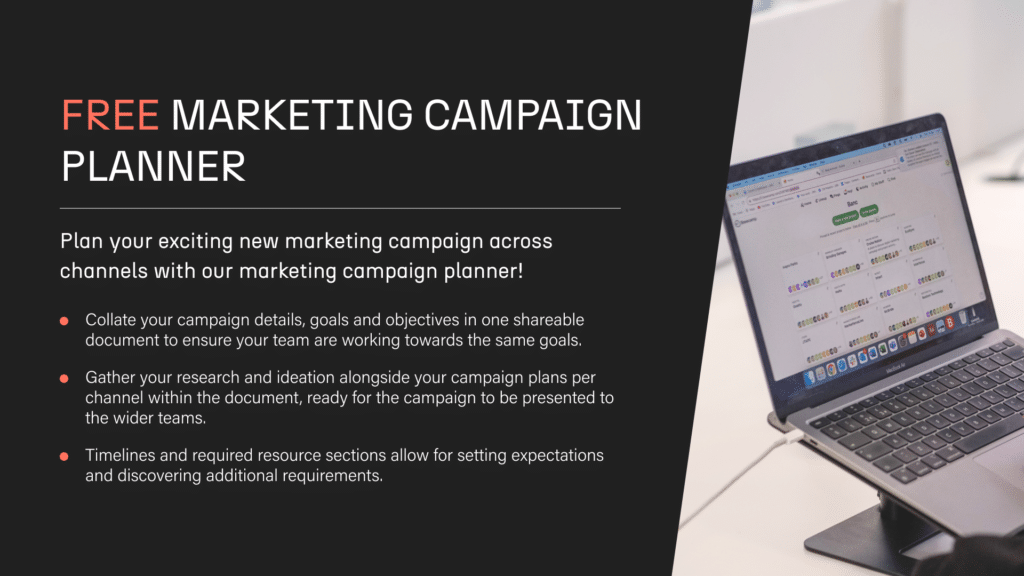How to Plan a Cross-Channel Marketing Campaign [with Download]
You’ve got your idea for a campaign formed. Now it’s time to give it some legs and make it a real runaway success. The good news is with so many different channels open to marketing teams, it’s never been easier to amplify your message across whatever platforms your audience uses, whether they read your content in an email, blog or on your social media.
Below, we’ll talk you through this cross-channel approach to marketing in more detail, show you how to plan it out as effectively as possible, and offer up insights on how to execute cross-channel activity in ways that’ll truly supercharge your campaigns. We’ve also created a free downloadable Marketing Campaign Planner for you to keep track of your ideas, plans and research with too!
Quick Navigation
What is cross-channel marketing?
Cross-channel marketing involves using a variety of marketing channels to manage your marketing campaigns with. With this approach, it’s possible to create a connected experience, one that leads audiences from one message to another in a seamless, cohesive way.
Cross-channel vs. multi-channel marketing
You might’ve heard the term multi-channel marketing used in the same breath as cross-channel before. And though they sound similar, the two disciplines differ. True, multi-channel marketing uses multiple channels to reach customers at a certain point on the customer’s journey. But multi-channel activity exists independently of each other, without cohesion between channels.
As a result, another key differentiator presents itself: when the customer moves from one channel to another in a multi-channel marketing campaign, they restart the journey at each new touchpoint. If this sounds counterintuitive and a little obsolete, it’s kind of because it is. A connected approach is fast becoming the preferred way of doing things, providing a clearer view of the customer journey for you and a better experience for your customer.

How to plan your cross-channel campaign strategy
Unify and use data for decision-making
Without customer data, targeting your audience gets a whole lot tougher. So before you do anything, collecting the right data will help you understand who your customers are and the places they frequent when they’re online.
By tracking URLs or browser cookies, you’ll be able to see the emails they’ve opened, the blogs they’ve read, the social media channels that struck a chord with them and the PPC campaigns they’ve clicked. With this data, you can find the link between these actions and your individual lead’s profile. And that is what’s going to help you paint a picture of the people you want to target.
Segment your audience
Now you’ve got your data, you can segment your target audience based on any trends that can be identified with regards to things like demographic, location, age, and preferred channels. With this info, you can then create tailored message and product offerings that cater to these audience segments.
Choose your channels
Not all channels will reach the audience in the manner you intended, so it’s important to be selective in the channels you to increase your chances of targeting them. Thankfully, the data you gathered earlier will shed light on the places and platforms your audience segments flock to more than others. Keep your campaign objectives in mind too. Are you capturing leads, generating impressions, or improving engagement for instance? Go for the channels that will best help you achieve these goals.
Timings
With all of the different channels you plan to use, timing is an issue you’ll have to consider – especially since there’s a whole bunch of factors you’ll need to tune in to, to make sure your messages have the right impact. Things like seasonality, trending topics, market conditions and what your competition’s doing all have their role to play. Striking while the iron is hot makes all the difference – be sure you aren’t posting things too early (or late) when it’s time to go live.
Outreaching your campaign across channels
So what’s available to you channel-wise, and how can they be used to make your cross-channel marketing campaign as effective as possible? Let’s take a look…
Email marketing
You can pack your emails with all sorts of content that can benefit the cross-channel method. You can nudge subscribers to a blog post on your website, get them to follow you on social media or make use of a discount you’re offering.
You can also use emails to collect further information about your subscribers, such as their birthday, anniversary, job profile, and what they like or dislike. This can be used to strengthen the quality and relevance of the messages you want to target them with.
Content marketing
By understanding their pain points and problems that need solving, creating tailored content in the form of blog posts that address the issues they’re having is a strong start. But you can strengthen this with irresistible calls-to-action across this content, pointing them back to your website or encouraging them to sign up to your newsletter, downloadable PDFs and other resources that appeal to their needs.
Paid media
Let’s say your audience is looking for a particular product that you have; in this case: stainless steel pans. You’ve set up a paid ad that targets the term “buy stainless steel pans” when typed into Google. Your audience clicks the Google Ad which takes them to your site. To order from you, they need to sign up. Doing so shares their email details with you – so that you can stay in touch with them, and vice versa!
Social media
Along with the use of visual content to engage with your audience, social media gives you the chance to interact with your customers – something other channels don’t offer. Not only do social media marketing campaigns let you increase brand awareness, engagement and even conversions, you can direct your traffic to other channels too, moving customers along the journey and getting them closer to your goals in a seamless way.
PR
Sure, digital PR is great for building high authority links, but it can achieve so much more. It can increase search demand and brand awareness, two things that can help create relevance, credibility and customer advocacy. So rather than creating content just for a link, take into consideration those goals we mentioned earlier, and tailor your stories to topics and press that your audience will want to read.
Out of Home
Don’t forget about digital billboards and outdoor signage that appear in stores, on the side of roads and just about every elsewhere these days. These digital out-of-home examples aren’t as static as traditional out-of-home methods, they can be updated and amended based on events (such as a sports team winning a game), a time of the day (such as a breakfast promotion) or even the weather.
Their cross-channel capabilities can make them doubly effective too. When they’re placed in high foot-traffic locations, not only are you increasing the reach, but with a call-to-action to encourage them to visit your store, or head to the website to make use of an offer, your audience can continue their journey with you later in the day at their pace.

Organising outreach
Create a calendar (and stick to it)
To make sure you know what content needs to go live – and when – a calendar is going to be essential. Cross-channel, by its definition, prevents siloes from forming. A content calendar creates a more unified team since everyone knows what that day’s activities are. Nobody is kept in the dark. And of course, if you create one, then stick to it! Timing is important, and if you miss your carefully planned out social post by a day, or forget to send that email that was supposed to coincide with World Book Day, then you could be missing out on some real opportunities.
Schedule
Scheduling can make sure the above doesn’t happen. By scheduling in activity to go live at the right time and on the correct channels, you can prevent potentially embarrassing situations from arising. Look at investing scheduling tools like Buffer or Mailchimp so you never let an opportunity go to waste again.
Monitor outreach activity
Of course, to make sure your campaigns are a success, you’ll need to measure their responses. You don’t want to keep repeating the same approach if it’s not getting you any closer to your goals. By monitoring how things have gone, you’ll know whether or not to continue what you’re doing – or whether you need to make some amendments to your activity.
Your free Marketing Campaign Planner

To help get your campaign planning off on the right foot, keep your research in one place and map out potential timelines, be sure to download this free Marketing Campaign Planner here.
Need a little extra direction from a team of experts? We’ll create a cross-channel marketing strategy that touches all the bases and syncs to your goals – whatever they are. Head over to our homepage or call us on 0345 459 0558 to see how we can help out.



